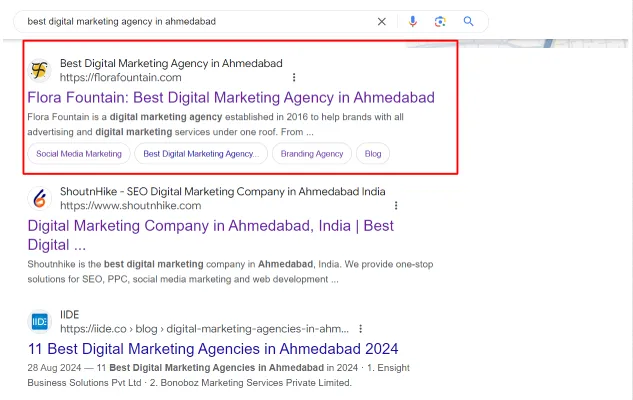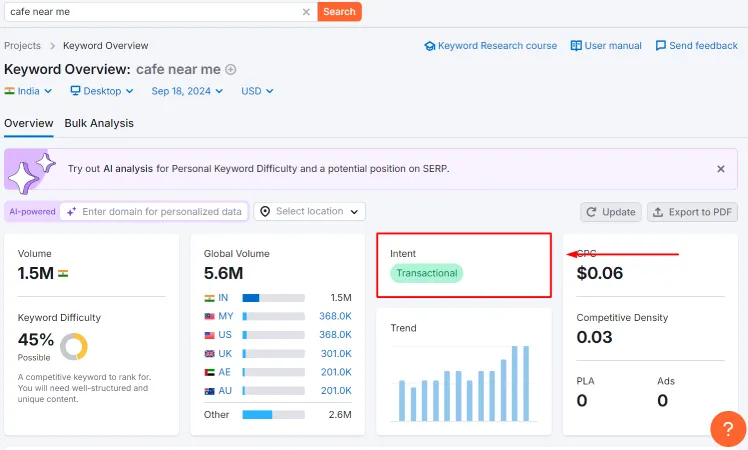
Ensuring SEO success is difficult but totally possible if you just make small changes in your existing strategy and keep yourself updated with Google’s changing algorithm.
For example, by implementing targeted strategies for one of our clients, we attracted over 92,000 organic monthly visitors to their website.
You can see the details in this screenshot

But it doesn’t stop there! We’ve also applied these strategies to our own site, and we’re thrilled to share that we’re ranking at the top of search engine results for the query “best digital marketing agency in Ahmedabad”.

We’d love to share some of the SEO tips that helped us achieve these impressive results. We hope it helps you ensure SEO success.
Table of contents
- Go Back To Basics — Optimise Technical SEO
- Master Keyword Intent and Clustering
- Focus on Relevance & E-E-A-T While Creating Content
- Optimise for Featured Snippets and SERP Features
- Stay Updated with SEO Trends & Adapt Your Strategies Accordingly
- In Conclusion
- Frequently Asked Questions
1. Go Back To Basics — Optimise Technical SEO
Before we dive into the fancier stuff, let’s get the basics sorted out. You cannot ensure SEO success without a strong technical foundation. If your site isn’t optimised technically, all your content, keyword research and link-building efforts will be wasted.
Fix the following aspects of technical SEO :
a. Site Architecture and Crawlability
Search engines need to crawl and index your site efficiently. What will help it crawl and index? A logical site architecture.
Make sure your site’s structure is clean, well-organised and easy for both users and bots to navigate.
Use a flat structure. This means every page is reachable within a few clicks from the homepage. It helps search engines index all your pages.
And of course interlink—wherever possible! This not only improves navigation but also distributes link juice across your site.
b. Mobile-Friendliness
With mobile-first indexing, your website’s mobile version is the primary reference for how your content is indexed and ranked. If your site doesn’t perform well on mobile, you’ll struggle to rank, no matter how optimised your desktop site is.
To ensure that it’s mobile-friendly, check with the team if the design is responsive meaning it adjusts well in different screen sizes.
Plus you can check your site’s mobile friendliness using a tool like Small SEO Tools and Lighthouse. You can share this with the tech team and ask for suggestions to make it more mobile-friendly.
c. Site Speed
If your page takes longer than 3 seconds to load, expect your bounce rate to skyrocket and your rankings to tank as well.
Fast sites rank better and keep users engaged.
While it’s mainly the developers’ job, you as an SEO professional can drive improvements too. Here’s how:
- Run speed tests using tools like Google PageSpeed Insights.
- Ask a developer to optimise images by using compressed formats.
- Suggest code minification to reduce load time and enable caching to improve repeat visit speeds.
2. Master Keyword Intent and Clustering
Let’s face it—keyword stuffing has been dead for years. Google’s algorithm has evolved into something far more advanced and to truly succeed, you need to understand search intent.
It’s not just about throwing random keywords into your content anymore; it’s about knowing what people really want when they search and aligning your content with that intent.
Not all keywords are the same. When people search for something, they usually have a specific intent in mind. Generally, search intent falls into one of three categories: navigational, informational or transactional.
Navigational keywords are when people are looking for a specific website, like typing “YouTube” into the search bar. Informational keywords are used when people are looking for knowledge or answers—maybe they want to know the best skincare routine for their skin type or learn more about SEO success.
Transactional keywords are used when people are ready to make a purchase. Think along the lines of “buy running shoes” or “best deals on smartphones.”
You can use the SEMRUSH tool to check the search intent of a particular keyword.
Just type the keyword in the tool and here’s where you will see the intent.

Once you identify the intent behind a keyword, the next step is to tailor your content to match it.
If you’re working with transactional keywords, make sure your landing page has a strong call-to-action (CTA) that encourages conversions.
On the other hand, if you’re targeting informational keywords, long-form content like detailed guides, how-tos or blog posts will perform best.
This approach not only helps your content rank but also ensures it resonates with your audience’s specific needs.
Additionally, rather than targeting one keyword per page, group similar keywords into clusters. This allows you to rank for multiple related terms without creating dozens of separate, thin content pages.
For example, if your primary keyword is “best SEO company in ahmedabad,” related keywords might include “good seo vs bad seo,” “top seo tips,” and “outsource seo.”
Try to use all these keywords within one in-depth piece.
3. Focus on Relevance & E-E-A-T While Creating Content
Creating amazing content that resonates with your audience is a must. Everyone knows it. But what makes content truly work for SEO? Well, it’s not just ✌informative content ✌—it’s informative, relevant, in-depth and fresh content.
Your content must address user pain points directly. Whether it’s a blog post, a product page or a service description, users are there to solve a problem. The more efficiently your content does that, the better it will perform.
Since Google’s August 2018 update, E-A-T—Expertise, Authority and Trustworthiness—has been crucial for ranking, especially for YMYL (Your Money or Your Life) sites (Sites that affect health, financial stability, happiness and financial stability of users)
Recently, Google added an extra ‘E’ for Experience. Now, demonstrating your real-world experience in addition to your expertise and authority is essential as per this update.
Expertise involves showcasing your credentials and qualifications. Experience means showing you’ve applied your knowledge in real situations. Make sure it reflects in your content. You can also mention the experience of the concerned person on the website like this

Authority is about linking to credible sources to back up your claims. Finally, Trustworthiness is built through transparency, with clear “About Us” pages and solid privacy policies.
4. Optimise for Featured Snippets and SERP Features
Google is increasingly focusing on a zero-click future where users get their answers directly on the search results page. Featured snippets, knowledge panels and other SERP features are becoming more prominent, pushing traditional blue links to the background. If you’re not optimising for these features, you might be missing out on significant traffic opportunities.
To make the most of this shift, start by identifying potential snippet opportunities. Look at your target keywords and see if any of them trigger featured snippets. Tools like Ahrefs and SEMrush are great for tracking these opportunities. Once you’ve identified them, tailor your content to address these questions directly.
When creating content to target featured snippets ask the writer to use question-based headers wherever possible. But make sure they use it only when it’s relevant.
For instance, we haven’t used question-based headers in this blog as this blog is about tips and the questions would be irrelevant.
Then, provide short, direct answers right below these headers—ideally, 40 to 50 words work best.
Incorporating bullet points or numbered lists can also be effective, especially for step-by-step guides or comparisons. This structured approach helps Google pick up your content for featured snippets.
Additionally, Google’s “People Also Ask” boxes offer another valuable way to capture user attention. By answering related questions within your content, you enhance your chances of appearing in these boxes.
And the easiest way to answer their queries is to directly write related FAQs and their answers at the end of the blog. This not only improves visibility but also helps cater to user queries more comprehensively.
5. Stay Updated with SEO Trends & Adapt Your Strategies Accordingly
The world of SEO is always shifting, so staying on top of the latest trends and algorithm updates is essential for maintaining success.
To keep your strategies sharp, make it a habit to follow authoritative SEO blogs and news sources like
And don’t just read! Implement the strategies that you read about. It will take a lot of trial and error but in the end—it will be worth it.
Conclusion
As an SEO professional, your job is to connect what users are searching for with what search engines prioritise. The strategies we’ve covered are not quick fixes—they’re part of a continuous effort to keep improving. SEO trends will change, algorithms will evolve and competition will only grow. The best way to stay ahead is by testing new ideas and always keeping an eye on what’s coming next.
Remember, SEO success doesn’t mean everything has to be perfect. It’s about making small, meaningful improvements that add up over time. So, take what you’ve learned, put it into action and keep evolving.
Cheers!



